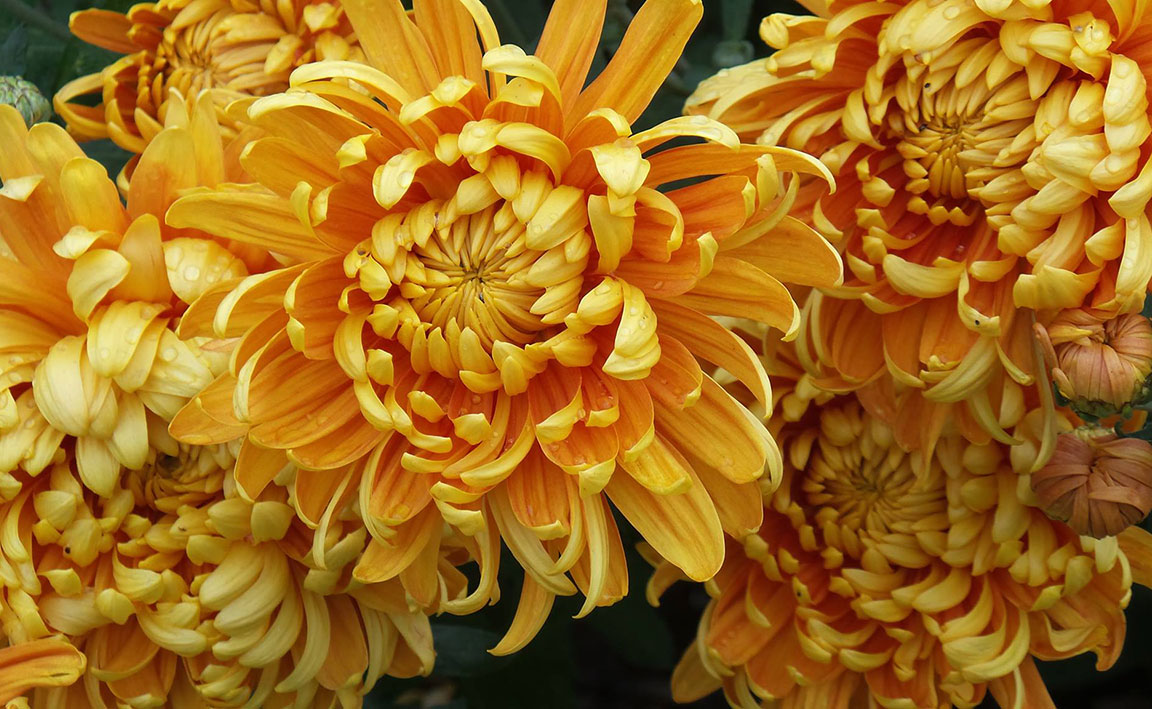
Maine Home Garden News — October 2018
- October Is the Month to . . .
- Avoid Ticks While Enjoying Your Garden
- Lindera benzoin: A Rare but Useful Shrub
- Blaine House Gardens
- Mainers Urged to Sign Up for Free Disposal of Unusable Pesticides
- Food & Nutrition: Relish
Please, let us know about the difference we have made in your gardening endeavors!
We hope you’ve enjoyed another year of Maine Home Garden News (MHGN). To continue receiving funding, UMaine Extension is asked to indicate what impacts we have made on the people we served in the past year. We would like to take the opportunity to gather your input regarding the topics presented in the 2018 season of MHGN. This 10-question survey should take only about 10 minutes to complete.
Thank you for taking the time to help us let our stakeholders know about the difference we have made in your gardening endeavors. Go to the survey to participate.
On behalf of the entire MHGN team,
Kate Garland, Horticulturist
October Is the Month to . . .
By Dave Fuller, Agriculture and Non-Timber Forest Products Professional, UMaine Extension Franklin County
- Learn more about Emerald Ash Borer (EAB). “(EAB), Agrilus planipennis, is one of the most serious invasive species threatening our ash resources and forests. All species of ash trees that grow in Maine are susceptible to injury and death by the emerald ash borer. EAB has recently been found in Aroostook Co. and York Co., ME.” Please read this News Release or call 207.287.2431, if you purchased an ash tree for planting this summer.
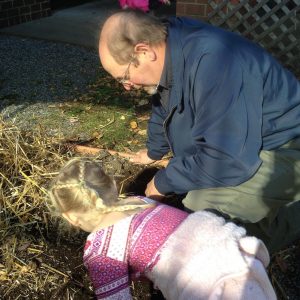
- Plant garlic. Garlic should be planted around the last week of October in all of the state except for Aroostook County, which should be planted by October 15. For information on planting garlic (with videos!), refer to Growing Hardneck Garlic in Your Maine Garden. Visit our Maine Seed Garlic Directory to find a listing of some of the suppliers in Maine. Some Maine seed companies and nurseries also carry garlic for planting. Avoid supermarket garlic for planting stock. Have a youngster help you plant garlic. The large cloves are easy to plant and they’ll see the garlic up in April!
- Plan to safely dispose of old pesticides. Sign up by October 5, 2018 to participate in the annual Obsolete Pesticide Disposal program coordinated by the Maine Board of Pesticides Control. More info below.
- Planting spring-flowering bulbs. There are hundreds of choices to make among varieties and plantings are long-lived. Some flowering bulbs are fragrant. Daffodils are not preferred by deer.
Here is more information, The Culture of Spring Flowering Bulbs.
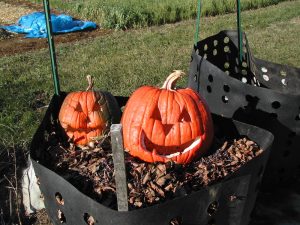
- Make garden records. What worked well for you this year? What was not so successful? Record what you planted where to fit in with a crop rotation to help avoid plant diseases and insect issues. Keep a Garden Record Book.
- Compost. Start a compost pile with all of the non-diseased plant material coming from your garden and tree leaves. Compost is an important component in a successful garden and is pricey to buy. Refer to, Home Composting.
- Test your soil. There is plenty of time to soil test and make necessary changes to your soil like pH and organic matter. After many years of no price increase, the Maine Soil Testing Service test is now $18 — still worth every penny! Get the form and boxes from your local county office or go to Maine Soil Request. Remember to test acid lovers like blueberries separately from your veggie garden. Become a better gardener by soil testing!
Avoid Ticks While Enjoying Your Garden
By Griffin Dill, Integrated Pest Management, UMaine Cooperative Extension, Orono
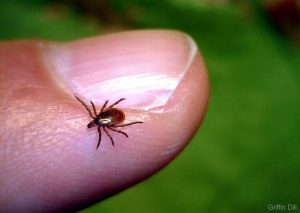
While fall is an excellent time to work in the garden, many gardeners may not realize that ticks can still pose a serious threat during these cooler months. Adult deer ticks (Ixodes scapularis) in particular are especially active during October, November, and even well into December depending on the temperature. Cases of tick-borne illness are increasing in Maine and ticks are being found in more locations, making it important to take precautions to minimize exposure. The deer tick is known to transmit a number of pathogens in Maine, including Lyme disease, anaplasmosis, babesiosis, and a strain of Powassan virus known as deer tick virus.
When enjoying the garden or working around the yard, it’s important to be mindful of the areas where ticks are most likely to be found. Ticks dry out easily and thus need habitat with relatively high humidity to survive. In general, ticks tend to be found in shady wooded areas, tall grass or brush, the edges where woods and lawn meet, in the leaf litter, beneath ground-cover plants, and around stone walls and wood piles where small mammals live.
It is a common misconception that ticks jump or fall from trees onto their hosts. In fact, ticks use a behavior known as questing to seek out animals or people on which to feed. When questing, ticks crawl to the top of low-lying vegetation and simply wait with outstretched legs for a suitable host to latch onto. To minimize the risk of being bitten by ticks, use a combination of the management and personal protection strategies described below.
Personal Protection
Before going out into the yard and garden, it’s important to first protect yourself against ticks and other biting pests. Create a barrier by tucking your shirt into your pants and your pant legs into your socks. Wear long-sleeved, light-colored clothing to make ticks more visible. Gardening gloves that extend slightly over the shirt sleeve will also help when picking up leaves, brush, or other garden debris.
Wear an EPA approved repellent, such as DEET or picaridin on exposed skin. Many gardeners have a dedicated set of clothing and a special pair of shoes or boots they wear in the garden. To take some of the forgetfulness out of using repellents, treat these dedicated garden clothes with permethrin. Permethrin lasts through multiple washes and has been shown to be highly effective at preventing tick bites.
Reduce Tick Habitat and Hosts
To create an environment around your yard and garden that discourages ticks, keep lawns mowed short, remove leaf litter and brush, and increase sunlight by pruning the lower branches of trees and thinning shrubs and hedges. Avoid the use of invasive plants such as Japanese barberry, as this plant provides the perfect cover and humid conditions for ticks to thrive. The sale of new Japanese barberry plants is now illegal in Maine, though you may consider removing any that have already been planted. For more information, see Methods for Disposing Non-Native Invasive Plants (PDF).
In addition to helping themselves to your garden’s bounty, deer and rodents play important roles in the tick life cycle. Try to reduce their presence by minimizing the use of bird feeders, putting up deer fencing and planting deer-resistant plant varieties. Keep woodpiles and stonewalls away from the home and free of tall grass, brush, and leaf litter to reduce rodent nesting sites.
When to Spray
The use of pesticides can be an effective tool in reducing tick populations around the yard and garden. Pesticides may pose a risk to you, your pets, and the environment, so be sure to use them safely and judiciously and always follow the label instructions. For the best results, it may be necessary to hire a licensed commercial pesticide applicator. Fall applications target the adult ticks and may help reduce populations the following year. A combination of a fall application and a spring application targeting the immature ticks can significantly minimize tick numbers.
Returning Indoors
When heading indoors after some time spent in the garden, be sure to closely examine your clothing and gear for ticks. Clothing can be placed directly in the dryer and tumbled on high heat to kill ticks. Conduct a full-body tick check by looking and feeling for ticks. Showering may help wash off any unattached ticks and provides the opportunity to thoroughly examine yourself. Ticks may be found anywhere on the body, particularly under the arms, behind the knees, between the legs, in and around the ears, in the belly button, and in the hair.
Remove attached ticks as soon as possible using a pair of fine-tipped tweezers or a tick removal spoon. Avoid using petroleum jelly, nail polish remover, a hot match, dish soap, or other folk remedies to remove ticks. These methods may potentially increase the risk of infection. Once the tick has been removed, it can be disposed of or saved for identification and disease testing. University of Maine Cooperative Extension currently offers free tick species identification and, starting in 2019, will test ticks for disease-causing organisms.
For More Information
For more information on ticks in Maine or to learn about submitting ticks to the Tick Lab, please visit the University of Maine Cooperative Extension Tick Identification Lab.
Lindera benzoin: A Rare but Useful Shrub
By Kookie McNerney, Home Horticulture Coordinator UMaine Cooperative Extension Cumberland County
Wild allspice, fever bush, Benjamin bush, and Northern spicebush are but a few of the common names for Lindera benzoin. This native shrub is a member of the Laurel family. Its most common name, Northern spicebush, is a true testament to one of its most appealing characteristics: the sweet and spicy fragrance emitted by the leaves, flowers and yes, even the bark.
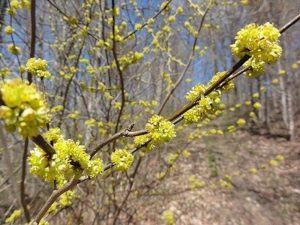
Yet this is not where the attraction stops. Lindera benzoin is a medium-sized, graceful, deciduous shrub with an open rounded habit, 6-12’ high and about as wide. The greenish-yellow flowers are unique in that they have no petals (apetalous) and appear very early, from April to May, making this an excellent substitution for the non-native forsythia. Indeed, sometimes it is referred to as the ‘Forsythia of the Wilds.’ Spicebush is also dioecious, meaning that the male and female flowers are borne on separate plants (just like holly); therefore, both are necessary for fruit production. The male flowers are slightly larger and showier than the female flowers, but the female flowers are not to be outdone. From the clusters of female flowers, oval red drupes are produced in fall.
Considered to be viable in zones 4-9, Maine is the northernmost boundary of this plant’s range. It is listed as a rare plant by the Maine Department of Agriculture, Forestry, and Conservation. The ideal location for spicebush is as an understory shrub with dappled light and evenly moist soil, although it is tolerant of a wide range of conditions. In its southern range, it is found along brooks and basin swamps. It can be used in rain gardens, borders, and naturalized areas. In more northerly reaches, it should be planted in an area protected from heavy snow and damaging winds. Its vibrant yellow fall foliage makes spicebush a wonderful 3-season plant. The plants reproduce asexually, by clonal root sprouts and are relatively free of disease problems.
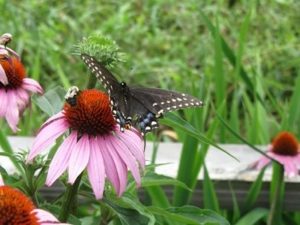
Lindera is a fabulous wildlife shrub. It is the larval host for the Spicebush Swallowtail butterfly, a favorite of the wood thrush, and over 20 other species of birds are attracted to its fruit. Rabbits, raccoons, and opossums browse the leaves.
All parts of the plant are edible. Young spring leaves can be incorporated into salads; the twigs and bark can be harvested throughout the year and steeped to make a refreshing tea when served with milk and honey. The berries can be eaten fresh or dried and ground to use as a spice, similar in flavor to allspice. The leaves, twigs, bark, and berries of Spicebush have been used by Native Americans to treat fever, coughs, colds, rheumatism, cramps, colic, and flatulence. There is a very small amount of camphor compound in the leaves, making it useful as an insect repellent.
What an incredibly useful and stunning shrub for a Maine garden.
Blaine House Gardens
By Ginny Wright, UMaine Cooperative Extension Master Gardener Volunteer Project Profile
One day last summer, Master Gardener Volunteers Karen Simpson and Peggy Mansir set to work tackling a large patch of goatsbeard that had overtaken an azalea bed in the historic New England Garden at the Blaine House, the 185-year-old governor’s mansion in Augusta. Digging up the bushy clumps of tall, spiky flowers, they soon had company: several of the Blaine House caretakers joined them in the garden to help give the azaleas some breathing room.
“The best thing about working here is the staff,” Karen says. “They are the nicest, most thoughtful people. They always make us feel appreciated.”
That’s because they are appreciated. “We would not have these beautiful gardens without them,” says Blaine House director Barbara A. Claudel. “We love them and are so happy they have a few more helpers this year.”
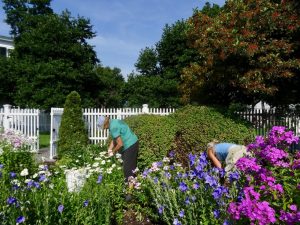
As a newly minted Master Gardener Volunteer in 2008, Karen Simpson was a member of the first team to tend the garden after an ambitious rehabilitation led by then-First Lady Karen Baldacci. Today, she coordinates the volunteers who show up at the Blaine House’s back gate once a week, armed with buckets, pruning shears, and assorted weeders. Along with Peggy, the team includes Bonnie Sammons, Jennifer Garron, Cal Brown, and occasionally, me.
Designed by Carl Rust Parker of the famous Olmsted Brothers landscape architectural firm, the New England Garden was part of master plan for the grounds commissioned by Governor Carl Milliken in 1920. By the time the Baldaccis moved into the house in 2003, however, little remained of Parker’s formal landscape. Where once there were perennial beds and paths surrounding a lawn, there was only grass and a few bedraggled shrubs. In fact, the garden had been pretty much forgotten until Mrs. Baldacci stumbled upon the original plan, rolled up in the back of a drawer in the Blaine House photocopying room.
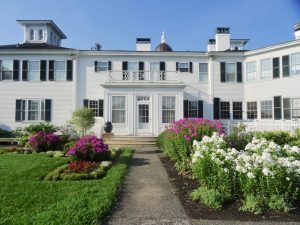
An avid gardener, Mrs. Baldacci’s curiosity was piqued. She contacted Earle Shettleworth, Jr., then the executive director of the Maine Historic Preservation Commission, who identified the plans. Then she joined forces with Friends of the Blaine House to raise funds to hire Boston landscape architect and Olmsted authority Marion Pressley to recreate the garden — with a few alterations. For example, Pressley chose the same plant species that Parker used, but substituted hardy varieties that hadn’t been available to him. In addition, she redrew some paths to suit the Blaine House’s rebuilt north entrance, and she retained an arborvitae privacy hedge that had been planted sometime after Governor Milliken’s tenure.
Located on the mansion’s north side just a block from Augusta’s busy Memorial Circle, the garden today is a hidden, tranquil oasis. At its center is a square lawn edged on all sides by paths. Each corner of the lawn is anchored by an L-shaped bed planted with a single Japanese dappled willow, or Hakuro-nishiki, pruned to a rounded lollipop form. At the willows’ feet are deep-pink phlox, pink coreopsis, pale-pink nicotiania, alyssum, impatiens, and Hummingbird clethra, a compact shrub with white spiky flowers that attract butterflies (and hummingbirds, of course!).
In the garden’s outer borders, lilacs and arborvitae provide a dense backdrop to a variety of simple, tough perennials and annuals: pink and white phlox, blue balloon flowers, catmints, irises, lady’s mantels, cranesbill geraniums, ferns, hostas, spirea — and, yes, goatsbeards, which are perfectly welcome in the right places. The garden is at its pinnacle in late July and early August, when the abundant phlox are in bloom.
Beginning in May and continuing into September, the volunteers meet at the gate on Tuesday mornings and are buzzed in together. The group then walks along the paths and agrees on what needs to be done during the next two hours. The Blaine House staff gardener rolls out a wheelbarrow to collect the weeds and cuttings for composting, and the lead event coordinator comes out with a small cooler filled with water, ice tea, and Gatorade. At the end of the season, First Lady Ann LePage typically invites the volunteers to join her for breakfast or lunch in the Blaine House dining room. The plants here may be familiar, but the gardening gig is one of a kind.
The New England Garden is open to the public for self-guided tours by appointment Tuesday–Thursday,
2–4 p.m., May 1 through October, 1.207.287.2301, blainehouse.org.
Mainers Urged to Sign Up for Free Disposal of Unusable Pesticides
By Maine DEP and Board of Pesticides Control
Contact: Megan Patterson, 207.287.2731, pesticides@maine.gov or John Bott, 207.287.3156, john.c.bott@maine.gov.
AUGUSTA — Unusable pesticides, such as weed killers (herbicides) and bug killers (insecticides), can be dangerous to humans, pets, and the environment. Pesticides can become unusable due to age, freezing or evaporation, or because their legal registration changes. Improper disposal of these products can contaminate land and water resources, including drinking water.
Participants must pre-register by October 5, 2018. Drop-ins are not permitted. Collections will occur at four sites: Presque Isle, Bangor, Augusta, and Portland.
Homeowners, family-owned farms, and greenhouses can dispose of unusable pesticides through the free Obsolete Pesticide Collection sponsored by the Maine Department of Agriculture, Conservation and Forestry’s (DACF) Board of Pesticides Control (BPC) and the Maine Department of Environmental Protection (DEP). The program is funded through product registration fees; since 1982 it has kept more than 103 tons of pesticides out of the waste stream.
“Providing Maine residents with a free and easy solution to properly dispose of pesticides gives everyone an opportunity to make a positive impact on our environment and public health,” said Paul Mercer, DEP Commissioner.
DACF Commissioner Walt Whitcomb is encouraging Mainers to seize this free opportunity. “It is not uncommon for people to find themselves with obsolete pesticides and not know how to dispose of them. It’s important for the protection of the public, wildlife, and environmental health that they are dealt with properly and not thrown in the trash or down the drain.”
To register and learn important information about the temporary storage and transportation of obsolete pesticides, go to the BPC website at thinkfirstspraylast.org or call 207.287.2731.
- For more information on the Maine Board of Pesticides Control: thinkfirstspraylast.org.
- For more information on the Maine Department of Environmental Protection: maine.gov/dep.
Food & Nutrition: Relish
By Kathy Savoie, MS, RD, Associate Extension Professor, UMaine Cooperative Extension Cumberland County
Relishes are the perfect complement to add interest to a meal or appetizer. Relishes are made from chopped fruits and/or vegetables cooked to a desired consistency in a spiced vinegar solution. The blending of these ingredients adds a slightly sweet and satisfying savory touch to special dishes or to simply top off a hotdog at a cookout! Either way, relishes are popular and come in many distinctive flavors.
The level of acidity in a relish is as important to safety as it is to taste and texture. When canning, never alter the proportions of vinegar, food, or water in a recipe and use only tested recipes for canning. By using tested recipes and following proper procedures, you can prevent the growth of Clostridium botulinum, which causes a type of food poisoning that can be fatal (botulism).
Ingredients
Vinegar: Acid ingredients, like vinegar, help preserve canned relishes as well as help give them their distinctive flavors. Use cider or white vinegar of five percent acidity. Cider vinegar has a good flavor and aroma, but may darken white or light colored fruits and vegetables. White distilled vinegar is often used for onions, summer squash, pears and apples where clearness of color is desired. Do not use homemade vinegar or vinegar of unknown acidity in making relishes. Do not dilute the vinegar unless the recipe specifies; you will be diluting the preservative effect.
Produce: Select tender vegetables and firm fruits that show no signs of mold or decay. To ensure quality, plan to make the relish within 24 hours after the fruits and vegetables are picked. If using cucumbers, always use a pickling variety of cucumber. Do not expect good quality pickled products if you use “table” or “slicing” cucumbers. If you buy cucumbers, select unwaxed ones for pickling because the brine or pickling solutions cannot penetrate the wax. Just before pickling, sort the fruits and vegetables and select the size best suited for the specific recipe. Rinse thoroughly under running water, especially around the stems. Soil trapped here can be a source of bacteria responsible for the softening of pickles. Do not use soap or detergent. Be sure to remove a 1/16-inch slice from the blossom end of the vegetables since it contains enzymes that also can cause softening.
Salt: Pure granulated salt, such as pickling or canning salt should be used. Other salts contain anti-caking ingredients that can make the relish cloudy.
Sugar: Use white sugar unless the recipe calls for brown. White sugar gives the product a lighter color, but brown sugar may be preferred for flavor. If you plan to use a sugar substitute, follow recipes developed for these products.
Spices: Use fresh whole spices for the best quality and flavor in relishes. Relishes will darken less if you tie whole spices loosely in a clean white cloth or cheesecloth bag and then remove the bag from the product before packing the jars. Powdered spices are recommended in some recipes but in others may cause the product to darken and become cloudy.
The University of Georgia Extension has a fact sheet, Preserving Food: Canning Relishes (PDF) full of relish recipes that can be downloaded for free to help you when preparing your relishes.
University of Maine Cooperative Extension’s Maine Home Garden News is designed to equip home gardeners with practical, timely information.
Let us know if you would like to be notified when new issues are posted. To receive e-mail notifications fill out our online form.
For more information or questions, contact Kate Garland at katherine.garland@maine.edu or 1.800.287.1485 (in Maine).
Visit our Archives to see past issues.
Maine Home Garden News was created in response to a continued increase in requests for information on gardening and includes timely and seasonal tips, as well as research-based articles on all aspects of gardening. Articles are written by UMaine Extension specialists, educators, and horticulture professionals, as well as Master Gardener Volunteers from around Maine, with Katherine Garland, UMaine Extension Horticulturalist in Penobscot County, serving as editor.
Information in this publication is provided purely for educational purposes. No responsibility is assumed for any problems associated with the use of products or services mentioned. No endorsement of products or companies is intended, nor is criticism of unnamed products or companies implied.
© 2018
Call 800.287.0274 (in Maine), or 207.581.3188, for information on publications and program offerings from University of Maine Cooperative Extension, or visit extension.umaine.edu.
